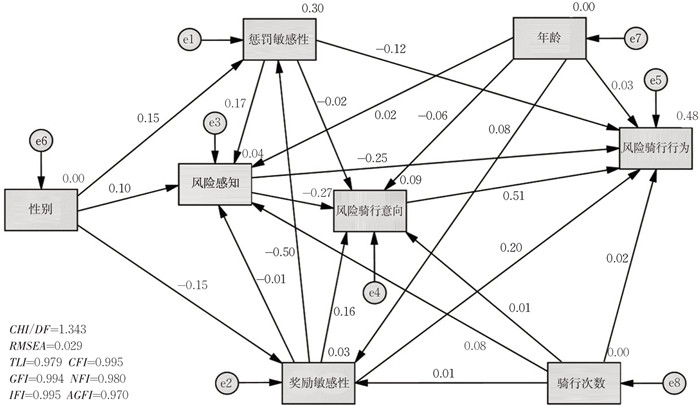Influencing Factors of Electrical Bikes'Risky Riding Behaviors Based on Reinforcement Sensitivity Theory
-
摘要: 从交通管理的奖惩机制角度,探究电动自行车骑行人的奖惩反应性对其风险骑行行为的影响机理。采用改进强化敏感性理论构建风险骑行行为的心理认知模型。在改进强化敏感性理论框架下,引入风险感知和风险骑行意向,同时考虑性别、年龄和骑行次数的影响,采用结构方程模型评估影响风险骑行行为的主要心理因素。通过问卷调查,共获取402个有效样本。研究结果表明:①修正后的心理认知模型对数据的适配性良好(χ2/df=1.343,RMSEA=0.029),能解释风险骑行行为48%的变异;②惩罚敏感性和奖励敏感性显著影响风险骑行行为,且奖励敏感性的影响程度更大;③风险感知和风险骑行意向显著影响风险骑行行为;④性别显著影响惩罚敏感性和奖励敏感性,且通过二者间接显著影响风险骑行行为;而年龄、骑行次数对各变量的影响均不显著。Abstract: From a traffic management perspective towards the reward and punishment strategies, the work studies the influence mechanisms of the reward and punishment responses of electric bike riders on their risky riding behaviors.A psychological cognitive model for risky riding behaviors is developed based on the revised reinforcement sensitivity.Perceived risk and risky riding intention are incorporated into the proposed framework, accounting for the potential impacts of gender, age, and riding frequency.The structural equation model is used to identify key psychological factors influencing risky riding behaviors with the self-reported survey data of 402 valid samples.The model-estimation results are as follows: ①The revised psychological cognitive model fits the data well(χ2/df=1.343, and RMSEA=0.029)and can explain 48%of the variance in risky riding behaviors.②Punishment sensitivity and reward sensitivity significantly affect risky riding behaviors, with the stronger influence of the latter.③Perceived risk and risky riding intention statistically affect risky riding behaviors.④Gender directly affects punishment sensitivity and rewardsensitivity and indirectly affects the risky riding behaviors via both variables.The influence of age and riding frequency on each variable is not significant.
-
表 1 变量描述性统计与相关关系
Table 1. Descriptive statistics and correlation coefficient for variables
题项 均值 方差 Cronbach's α系数 变量 1 2 3 4 5 6 7 8 1.性别 1 0.020 -0.026 0.223** -0.142** 0.056 -0.029 0.008 1.351 0.478 2.年龄 1 -0.045 -0.031 0.071 0.025 -0.053 0.017 2.552 1.096 3.骑行次数 1 0.014 0.012 0.079 -0.003 -0.003 2.192 0.790 4.惩罚敏感性 1 -0.523** 0.154** -0.062 -0.214** 2.381 0.669 0.822 5.奖励敏感性 1 -0.091 0.150** 0.316** 2.595 0.531 0.794 6.风险感知 1 -0.255** -0.346** 4.044 0.826 0.851 7.风险骑行意向 1 0.611** 1.528 0.711 0.911 8.风险骑行行为 1 1.738 0.700 0.887 注:**表示p < 0.01 表 2 模型修正前后的适配指标
Table 2. Degree-of-fit indices for original and modified models
适配指标 χ2/df RMESA GFI NFI IFI CFI TLI AGFI 参考标准 < 3 < 0.08 >0.9 >0.9 >0.9 >0.9 >0.9 >0.9 初始模型 30.224 0.270 0.939 0.749 0.755 0.742 0.804 0.448 修正后模型 1.343 0.029 0.994 0.980 0.995 0.995 0.979 0.970 表 3 修正后模型路径检验
Table 3. Path-testing results for the modified model
路径假设 模型路径 非标准化路径系数 S.E. C.R. P 标准化路径系数 假设是否成立 H1 惩罚敏感性 → 风险感知 0.208 0.072 2.882 0.004 0.168 假设成立 H2 惩罚敏感性 → 风险骑行意向 -0.020 0.060 -0.335 0.738 -0.019 假设不成立 H3 惩罚敏感性 → 风险骑行行为 -0.124 0.044 -2.785 0.005 -0.118 假设成立 H4 奖励敏感性 → 风险感知 -0.018 0.090 -0.206 0.837 -0.012 假设不成立 H5 奖励敏感性 → 风险骑行意向 0.218 0.075 2.918 0.004 0.163 假设成立 H6 奖励敏感性 → 风险骑行行为 0.265 0.056 4.724 *** 0.202 假设成立 H7 风险感知 → 风险骑行意向 -0.229 0.042 -5.506 *** -0.266 假设成立 H8 风险感知 → 风险骑行行为 -0.212 0.032 -6.628 *** -0.251 假设成立 H9 风险骑行意向 → 风险骑行行为 0.500 0.037 13.467 *** 0.508 假设成立 H10 性别 → 惩罚敏感性 0.209 0.059 3.526 *** 0.149 假设成立 H11 性别 → 奖励敏感性 -0.165 0.055 -3.014 0.003 -0.148 假设成立 H12 性别 → 风险感知 0.168 0.087 1.932 0.053 0.097 假设不成立 H16 年龄 → 奖励敏感性 0.039 0.024 1.618 0.106 0.080 假设不成立 H17 年龄 → 风险感知 0.016 0.037 0.420 0.675 0.021 假设不成立 H18 年龄 → 风险骑行意向 -0.038 0.031 -1.229 0.219 -0.059 假设不成立 H19 年龄 → 风险骑行行为 0.021 0.023 0.890 0.373 0.032 假设不成立 H21 骑行次数 → 奖励敏感性 0.007 0.033 0.218 0.827 0.011 假设不成立 H22 骑行次数 → 风险感知 0.089 0.051 1.728 0.084 0.085 假设不成立 H23 骑行次数 → 风险骑行意向 0.012 0.043 0.283 0.777 0.013 假设不成立 H24 骑行次数 → 风险骑行行为 0.019 0.032 0.586 0.558 0.021 假设不成立 H25 奖励敏感性 → 惩罚敏感性 -0.631 0.053 -11.830 *** -0.501 假设成立 注:***表示P<0.001 -
[1] 公安部交通管理局. 2017年中华人民共和国道路交通事故统计年报[R]. 无锡: 公安部交通管理局, 2018.Traffic Management Bureau of the Ministry of Public Security. The people's republic of China road traffic accident annual statistic report[R]. Wuxi: Traffic Management Bureau of the Ministry of Public Security, 2018. (in Chinese). [2] CHEN Qiang, DAI Bing. Characteristics and casualty analysis of two-wheeler accidents in China, data source: The China in-depth accident study(CIDAS)[J]. SAE Technical Paper, 2018(1): 1-10. http://www.researchgate.net/publication/324409743_Characteristics_and_Casualty_Analysis_of_Two-_Wheeler_Accidents_in_China_Data_Source_The_China_In-Depth_Accident_Study_CIDAS [3] WU Changxu, YAO Lin, ZHANG Kan. The red-light running behavior of electric bike riders and cyclists at urban intersections in China: An observational study[J]. Accident Analysis & Prevention, 2012, 49(11): 186-192. http://www.ncbi.nlm.nih.gov/pubmed/23036395 [4] PAI C W, JOU R C. Cyclists'red-light running behaviors: An examination of risk taking, opportunistic, and law-obeying behaviors[J]. Accident Analysis & Prevention, 2014(62): 191-198. http://www.ncbi.nlm.nih.gov/pubmed/24172086 [5] 李英帅, 张旭, 王卫杰, 等. 基于随机森林的电动自行车骑行者事故伤害程度影响因素分析[J]. 交通运输系统工程与信息, 2021, 21(1): 196-200. https://www.cnki.com.cn/Article/CJFDTOTAL-YSXT202101032.htmLI Yingshuai, ZHANG Xu, WANG Weijie, et al. Factors affecting electric bicycle rider injury in accident based on random Forest model[J]. Journal of Transportation Systems Engineering and Information Technology, 2021, 21(1): 196-200. (in Chinese). https://www.cnki.com.cn/Article/CJFDTOTAL-YSXT202101032.htm [6] 何庆, 马建菲, 李洋, 等. 基于122警情的电动自行车交通事故特征研究[J]. 交通信息与安全, 2018, 36(5): 132-138. doi: 10.3963/j.issn.1674-4861.2018.05.017HE Qing, MA Jianfei, LI Yang, et al. A study of characteristics of road accidents involve electric bicycles based on 122 emergency number[J]. Journal of Transport Information and Safety, 2018, 36(5): 132-138. (in Chinese). doi: 10.3963/j.issn.1674-4861.2018.05.017 [7] YANG Xiaobao, HUAN Mei, ABDEL-ATY M, et al. A hazard-based duration model for analyzing crossing behavior of cyclists and electric bike riders at signalized intersections[J]. Accident Analysis & Prevention, 2015(74): 33-41. http://smartsearch.nstl.gov.cn/paper_detail.html?id=cbaa0e78017807ec30b13578bd8263eb [8] FRABONI F, MARÍN PUCHADES V, DE ANGELIS M, et al. Red-light running behavior of cyclists in Italy: An observational study[J]. Accident Analysis & Prevention, 2018(120): 219-232. http://www.ncbi.nlm.nih.gov/pubmed/30172107 [9] SCHLEINITZ K, PETZOLDT T, KRÖLING S, et al. (E-)Cyclists running the red light-the influence of bicycle type and in-frastructure characteristics on red light violations[J]. Accident Analysis & Prevention, 2019(122): 99-107. http://www.ncbi.nlm.nih.gov/pubmed/30340148 [10] ZHANG Yiqi, WU Changxu. The effects of sunshields on red light running behavior of cyclists and electric bike riders[J]. Accident Analysis & Prevention, 2013(52): 210-218. http://europepmc.org/abstract/med/23348101 [11] TANG Tianpei, WANG Hua, MA Jie, et al. Analysis of crossing behavior and violations of electric bikers at signalized intersections[J/OL]. (2020-01)[2020-08-10]. https://www.hindawi.com/journals/jat/2020/3594963/. [12] YAO Lin, WU Changxu. Traffic safety for electric bike riders in China attitudes, risk perception, and aberrant riding behaviors[J]. Transportation Research Record, 2012, 2314(1): 49-56. doi: 10.3141/2314-07 [13] YANG Hongtai, LIU Xiaohan, SU Fan, et al. Predicting e-bike users'intention to run the red light: An application and extension of the theory of planned behavior[J]. Transportation Research Part F: Traffic Psychology and Behaviour, 2018(58): 282-291. http://www.sciencedirect.com/science/article/pii/S1369847817306976 [14] GRAY J A. The Psychophysiological basis of introversion-extraversion[J]. Behaviour Research and Therapy, 1970, 8(3): 249-266. doi: 10.1016/0005-7967(70)90069-0 [15] CONSTANTINOU E, PANAYIOTOU G, KONSTANTINOU N, et al. Risky and aggressive driving in young adults: Personality matters[J]. Accident Analysis & Prevention, 2011, 43(4): 1323-1331. http://www.ncbi.nlm.nih.gov/pubmed/21545861 [16] CASTELLA J, PEREZ J. Sensitivity to punishment and sensitivity to reward and traffic violations[J]. Accident Analysis & Prevention, 2004, 36(6): 947-952. http://europepmc.org/abstract/MED/15350871 [17] SCOTT-PARKER B, WATSON B, KING M J, et al. The influence of sensitivity to reward and punishment, propensity for sensation seeking, depression, and anxiety on the risky behaviour of novice drivers: A path model[J]. British Journal of Psychology, 2012, 103(2): 248-267. doi: 10.1111/j.2044-8295.2011.02069.x [18] GRAY J, MCNAUGHTON N. The neuropsychology of anxiety an enquiry into the functions of the septo-hippocampal system[M]. 2nd Ed. Oxford: Oxford University Press, 2000. [19] CORR P J, COOPER A J. The reinforcement sensitivity theory of personality questionnaire(RST-PQ): Development and validation[J]. Psychological Assessment, 2016, 28(11): 1427-1440. doi: 10.1037/pas0000273 [20] HARBECK E L, GLENDON A I. How reinforcement sensitivity and perceived risk influence young drivers'reported engagement in risky driving behaviors[J]. Accident Analysis & Prevention, 2013(54): 73-80. [21] AJZEN I. The theory of planned behavior[J]. Organizational Behavior and Human Decision Processes, 1991, 50(2): 179-211. doi: 10.1016/0749-5978(91)90020-T [22] SCOTT-PARKER B, WATSON B, KING M J, et al. Confirmatory factor analysis of the behaviour of young novice drivers scale(BYNDS)[J]. Accident Analysis & Prevention, 2012(49): 385-391. http://www.ncbi.nlm.nih.gov/pubmed/23036417 [23] HARBECK E L, GLENDON A I, HINE T J. Reward versus punishment: Reinforcement sensitivity theory, young novice drivers'perceived risk, and risky Driving[J]. Transportation Research Part F: Traffic Psychology and Behaviour, 2017(47): 13-22. http://www.sciencedirect.com/science/article/pii/S136984781630170X [24] D'ARCY J, HERATH T. A review and analysis of deterrence theory in the is security literature: Making sense of the disparate findings[J]. European Journal of Information Systems, 2011, 20(6): 643-658. doi: 10.1057/ejis.2011.23 [25] MURPHY K, HELMER I. Testing the importance of forgiveness for reducing repeat offending[J]. Australian and New Zealand Journal of Criminology, 2013(46): 138-156. [26] FLOYD D L, PRENTICE-DUNN S, ROGERS R W. A meta-analysis of research on protection motivation theory[J]. Journal of Applied Social Psychology, 2000(30): 407-429. doi: 10.1111/j.1559-1816.2000.tb02323.x [27] HOLLAND C, HILL R. The effect of age, gender and driver status on pedestrians'intentions to cross the road in risky situations[J]. Accident Analysis & Prevention, 2007, 39(2): 224-237. http://europepmc.org/abstract/MED/16979132 [28] ZHOU Ronggang, HORREY W J, YU Ruifeng. The effect of conformity tendency on pedestrians'road-crossing intentions in China: An application of the theory of planned behavior[J]. Accident Analysis & Prevention, 2009, 41(3): 491-497. http://her.oxfordjournals.org/external-ref?access_num=19393798&link_type=MED [29] CHORLTON K, CONNER M, JAMSON S. Identifying the psychological determinants of risky riding: An application of an extended theory of planned behaviour[J]. Accident Analysis & Prevention, 2012(49): 142-153. http://www.ncbi.nlm.nih.gov/pubmed/23036391 [30] MATSUI Y, OIKAWA S. Situational characteristics of fatal pedestrian accidents involving vehicles traveling at low speeds in Japan[J]. Traffic Injury Prevention, 2019(20): 1-6. doi: 10.1080/15389588.2019.1587166?src=recsys& [31] CASTANIER C, DEROCHE T, WOODMAN T. Theory of planned behaviour and road violations: The moderating influence of perceived behavioural control[J]. Transportation Research Part F: Traffic Psychology and Behaviour, 2013(18): 148-158. http://www.sciencedirect.com/science/article/pii/S136984781300017X [32] NEMME H E, WHITE K M. Texting while driving: psychosocial influences on young people's texting intentions and behaviour[J]. Accident Analysis & Prevention, 2010, 42(4): 1257-1265. -





 下载:
下载:

